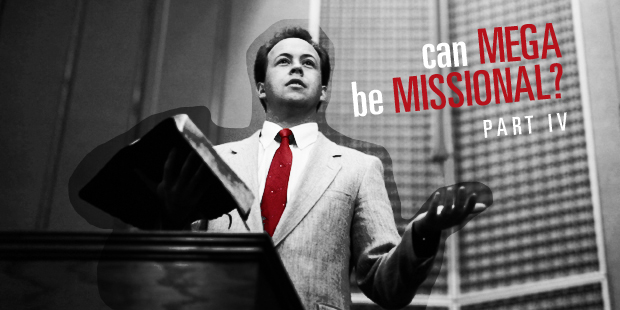
Can Mega Be Missional, Part 4
When many hear the word megachurch, they think of polished productions, big personalities, an expansive building, stellar programs (lots and lots of programs), and crowded parking lots with orange-vested attendants. Maybe a great worship service that leaves you laughing, crying, or both. Or perhaps a creative children’s ministry– kind of a Jesus-meets-ChuckECheese type of place.
But there are megachurches in America that are undermining the stereotypical view of themselves– for the glory of God. I have already written of three realms where mega churches are making a missional impact. Today as I continue my series I will give you the final two of five realms.
Holistic Disciple Making
Perhaps one of the greatest obstacles to megachurches being missional is the ease with which individuals can simply blend into the large crowds, remaining faithful as attendees but disengaged from other members and uninvolved in service and outreach. However, some megachurches are reversing this trend by reorienting their members to the centrality of Jesus’ message: discipling people toward living their lives in outward ways, like missionaries.
For megachurches, a praxis style of discipleship is catching on, whereby seasoned servant/disciples are taking others hand in hand to the real places of ministry, quite often beyond the church campus itself. Teaching church members to live their lives from a missionary stance is 16,000-member Phoenix First Assembly in Arizona, which sends enthusiastic, well-organized teams to conduct more than a dozen outreaches, transform neighborhoods, and break the cycle of poverty and violence.
Through one ministry called Sponsor-a-Bus, Phoenix First Assembly picks up people for church– and nine bus routes operate throughout the week to serve the disabled, elderly, and nursing home residents often forgotten by society. Its independent fleet of 34 buses is recognized nationwide for serving the Phoenix metro area.
From my observations, some megachurches are training members to live with a 24/7 missional focus. That is encouraging to me.
Church Multiplication
A few years ago, the title “fastest-shrinking megachurch” may go to New Hope Christian Fellowship O’ahu in Honolulu, Hawaii, led by Wayne Cordeiro. Attendance was dropping like a rock. But Cordeiro seems pretty happy about it. On the surface, going from 12,000 weekend attendees to 9,200 may seem like decline. But by planting 83 new churches, New Hope continues to reseed itself by multiplying churches rather than adding to its own numbers. Cordeiro plans to plant New Hope’s 100th church by 2010.
In recent years, church planting has gained tremendous traction. And many megachurches are now embracing a missional vision for church multiplication. Notice I did not say church planting– these churches are not interested in simply planting one church at a time, but are leveraging their resources to multiply or plant several churches on an annual basis.
A prime example of a megachurch that engages in church multiplication is New York-based Redeemer Presbyterian led by Tim Keller. With an average weekly attendance in the thousands, it has participated in more than 100 church plants and sets aside millions for the Redeemer Church Planting Center. Redeemer is a model of local church leaders assuming significant responsibility for planting churches, not leaving the leadership to their denominations.
By making church planting a priority, some megachurches are discovering that growth is experienced on both sides– not only do daughter churches see new growth, but involved mother churches are also seeing their members strengthened to reach more unchurched members of their community.
In my next blog in the series I will wrap up the discussion for now.
Read the previous posts from this series: Part 1; Part 2; Part 3.
Read more from Ed here.

Tags: Ed Stetzer, Leadership Engine, Mega-church, Missional













